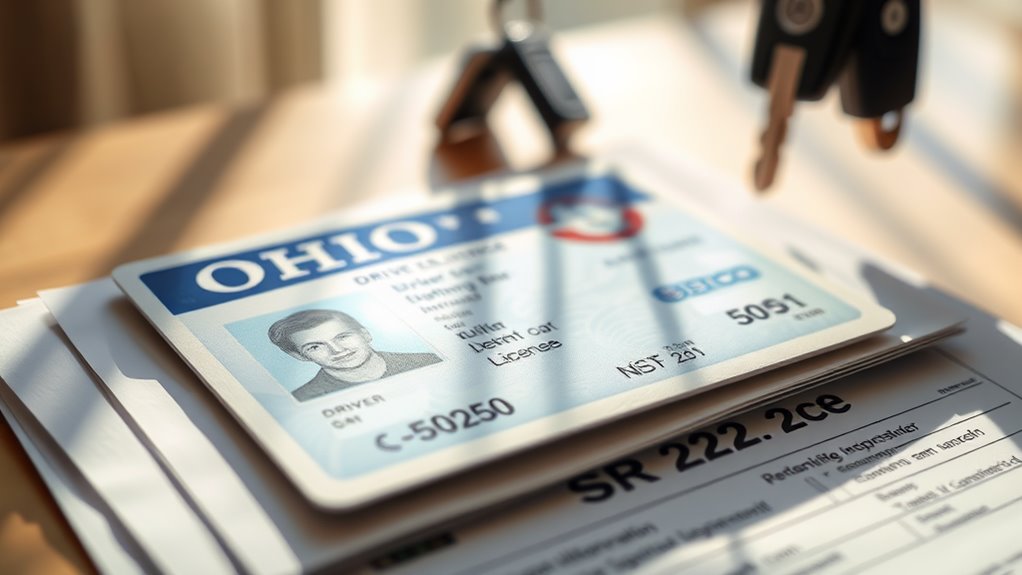If you’ve faced serious traffic violations in Ohio, you may need SR-22 insurance to regain your driving privileges. This certification proves you have the necessary minimum liability coverage. Understanding the requirements and implications of SR-22 can help you navigate this process more effectively. What are the specific reasons you might need this coverage, and how does it impact your insurance premiums? Let’s explore these critical details.
Key Takeaways
- SR-22 is a certification proving minimum liability coverage, required for high-risk drivers in Ohio after certain violations.
- Minimum liability coverage in Ohio includes $25,000 per person and $50,000 per accident for bodily injury, plus $25,000 for property damage.
- To obtain SR-22 insurance, contact licensed providers, complete an application, and ensure they file the SR-22 form with the Ohio BMV.
- Non-compliance, such as lapses in coverage, leads to immediate license suspension and higher premiums upon reinstatement.
- The average annual cost for SR-22 insurance in Ohio is around $1,703, influenced by driving violations and coverage types.
Understanding SR-22 Insurance

When you face serious driving violations like a DUI or an uninsured accident, understanding SR-22 insurance is vital for getting your license back.
An SR-22 isn’t an insurance policy; it’s a document proving you have the minimum liability coverage required by your state. It acts as a financial responsibility certification, filed through your insurer.
In Ohio, the Bureau of Motor Vehicles (BMV) mandates SR-22 filings for 3-5 years, depending on your violation’s severity. You’ll need to maintain continuous coverage without lapses, or you risk losing your license again. This ensures that high-risk drivers are held accountable for their financial responsibilities.
Your insurance premiums will likely increase considerably, so it’s wise to compare multiple insurers to find competitive rates on SR-22 policies. Compliance is essential to avoid further penalties and complications.
Reasons You May Need an SR-22
There are several reasons you might need an SR-22 in Ohio, particularly if you’ve faced serious driving infractions.
If you’ve been convicted of Driving Under the Influence (DUI) or Operating a Vehicle Impaired (OVI), an SR-22 is often required. Additionally, multiple serious traffic offenses can trigger this requirement.
If you’ve been caught driving without insurance or involved in an at-fault accident without adequate coverage, you’ll likely need to file an SR-22. Coverage must remain active during the required duration to avoid penalties.
License suspension or revocation also necessitates an SR-22 to reinstate your driving privileges.
In any of these scenarios, maintaining SR-22 insurance proves your financial responsibility, allowing you to regain your driving rights and comply with state regulations.
Minimum Liability Coverage Requirements in Ohio
In Ohio, drivers must maintain minimum liability coverage to guarantee financial responsibility in the event of an accident. The state requires specific coverage limits:
- $25,000 per person for bodily injury liability
- $50,000 per accident for total bodily injury liability
- $25,000 for property damage liability per accident
Proof of financial responsibility is mandatory during traffic stops or accidents. Alternatives include a $30,000 bond or self-insurance certificates.
While these minimums help in legal compliance, they may not provide sufficient protection in severe accidents. You could face out-of-pocket costs or personal liability for damages exceeding your coverage limits.
It’s wise to evaluate additional coverage options to better protect yourself and your assets.
How to Obtain SR-22 Insurance

If you’ve been required to obtain SR-22 insurance, understanding the process is essential to regaining your driving privileges.
Start by contacting licensed insurance providers in Ohio. You’ll need to complete a standard application process to qualify for coverage.
Once approved, your insurer will file the SR-22 form with the Ohio Bureau of Motor Vehicles (BMV) on your behalf, which typically takes about 72 hours.
After approval, your insurer will submit the SR-22 form to the Ohio BMV, usually within 72 hours.
Remember, maintaining continuous coverage is vital; any lapse can lead to another license suspension.
Additionally, be aware that you’ll need to pay a reinstatement fee and comply with any other BMV conditions.
Following these steps will help guarantee you meet all requirements and restore your driving rights efficiently.
The Impact of SR-22 on Insurance Premiums
While you may expect your insurance premiums to rise after obtaining SR-22 insurance, the extent of the increase can vary considerably based on several factors.
The average annual cost for SR-22 insurance in Ohio is around $1,703, but this can change depending on:
- Severity of driving violations (e.g., DUI)
- Insurance company policies on high-risk drivers
- Type of coverage selected (full vs. basic)
- Your demographics (age, credit score)
- Geographic location (ZIP code)
These elements play a significant role in determining your overall premium.
Maintaining a clean driving record during the SR-22 requirement period can help mitigate costs, but be prepared for potential long-term impacts on your insurance rates.
Alternatives to SR-22 Insurance
If you’re looking for alternatives to SR-22 insurance in Ohio, consider a Financial Responsibility Bond, which can meet state requirements without being a traditional policy.
You might also explore various alternative insurance options that cater to high-risk drivers.
These alternatives can help you maintain compliance while potentially lowering your overall costs.
Financial Responsibility Bond
A Financial Responsibility Bond (FR bond) serves as a practical alternative to SR-22 insurance for those needing to prove financial responsibility in Ohio. This option can be more affordable and flexible, offering coverage without the need for traditional auto insurance.
Here are some key aspects:
- Provides liability coverage for bodily injury and property damage.
- Covers the individual, not tied to a specific vehicle.
- Requires a bond amount of at least $30,000, typically $32,500.
- Issued by authorized insurance companies and regulated by the Ohio Department of Insurance.
- Ideal for non-vehicle owners or those who find insurance unaffordable.
This bond guarantees compliance with Ohio’s financial responsibility laws while avoiding penalties like license suspension.
Alternative Insurance Options
Exploring alternative insurance options can help you meet Ohio’s SR-22 requirements without the high costs of traditional policies.
Consider non-owner car insurance, which provides liability coverage if you don’t own a vehicle and can be cheaper for high-risk drivers.
Public transportation is another viable option, especially in urban areas, potentially saving you $1,000-$5,000 annually.
If you’re open to cycling or walking, you can eliminate insurance needs altogether, though it may depend on weather and distance.
Rideshare services offer flexible commuting without insurance obligations, but costs can add up for frequent use.
Finally, suspending vehicle ownership by surrendering your plates can help, but be aware of potential reinstatement fees and SR-22 filing extensions.
Duration of SR-22 Requirements
In Ohio, the duration of your SR-22 requirement typically falls between three to five years, depending on your specific violations.
More severe offenses can extend this period, so it’s essential to maintain continuous coverage to avoid penalties.
The BMV regularly checks for compliance, and any lapse in insurance could lead to immediate suspension of your driving privileges.
Duration Based on Offense
While the duration of SR-22 requirements in Ohio primarily hinges on the severity of the offense, drivers can generally expect coverage to last anywhere from three to five years.
Here’s what you should know:
- Common Duration: Most drivers face a three-year SR-22 requirement.
- Extended Coverage: Severe offenses may lead to a five-year duration.
- Continuous Coverage: Maintaining active insurance throughout is essential.
- Penalties for Lapses: Any lapse in coverage can result in penalties, including license suspension.
- Individual Circumstances: Courts or the Bureau of Motor Vehicles may adjust durations based on specific cases.
Understanding these factors can help you navigate the SR-22 process and guarantee compliance to avoid further complications.
Periodic Compliance Checks
To guarantee you maintain your SR-22 requirements, Ohio conducts periodic compliance checks throughout the mandated coverage period. These checks ascertain you keep your SR-22 insurance active, avoiding penalties like license suspension.
The Ohio BMV utilizes a monitoring system to regularly review SR-22 filings. If your insurer cancels or lapses your policy, they must notify the BMV immediately. You’ll also receive mail notifications if there are issues with your filing.
Insurers are responsible for filing your SR-22 forms and updating any changes. By keeping your compliance status in check, you can prevent unwanted driving permit restrictions and additional fees for reinstatement.
Utilize online tools for tracking your SR-22 status efficiently.
Consequences of Non-Compliance
Failing to comply with SR-22 insurance requirements in Ohio can lead to serious consequences that greatly impact your driving privileges and financial situation.
Here’s what you might face:
- Immediate suspension of your license upon any lapse in SR-22 coverage.
- Major violations added to your record for driving during suspension.
- Multi-year suspensions for repeat offenses, ranging from 1 to 2 years.
- Financial penalties, including reinstatement fees and increased insurance premiums.
- Legal troubles, such as insurance fraud charges if you submit false proof of coverage.
Ignoring these requirements can have long-lasting effects, making it essential to stay compliant with all SR-22 obligations to avoid dire repercussions.
Reinstating Your Driving Privileges

Reinstating your driving privileges in Ohio after a suspension requires careful attention to specific steps and requirements.
First, you must serve the full suspension period imposed by the BMV. Once that’s complete, obtain an SR-22 certificate from your insurance provider and verify it’s filed with the Ohio BMV.
Next, gather necessary documents, including proof of insurance, and pay the reinstatement fees, which start at $40.
If applicable, complete any mandated court or BMV programs, such as defensive driving courses.
Finally, submit your reinstatement paperwork in person at a local BMV office.
Following these steps will help you regain your driving privileges and comply with all legal requirements.
Tips for Managing SR-22 Insurance Costs
To manage your SR-22 insurance costs effectively, start by shopping around for quotes from multiple providers.
Maintaining continuous coverage and considering higher deductibles can also lead to significant savings.
Shop Around Quotes
When you’re managing SR-22 insurance costs, shopping around for quotes is crucial to finding the best deal. By comparing different providers, you can potentially save hundreds each year.
Here are some tips to guide you:
- Compare top providers: Mile Auto offers $45, while State Farm is at $48.
- Prioritize violations-specific quotes: Rates differ based on your driving record.
- Check multi-company platforms: Use aggregators to explore options like GEICO and The General.
- Confirm SR-22 inclusion: Verify quoted rates cover filing fees ($15-$25).
- Annual savings potential: Switching can save you $500+ annually, depending on your situation.
Taking the time to shop around will help you find the most affordable SR-22 insurance.
Maintain Continuous Coverage
Maintaining continuous coverage is essential not just for compliance with SR-22 requirements but also for protecting your driving privileges.
An SR-22 isn’t an insurance policy; it’s a certificate verifying you have the minimum liability coverage mandated by law. Any lapse in your coverage can lead to severe penalties, including the suspension of your driving privileges.
Typically, you need to maintain this coverage for three to five years, depending on the offense. If you incur additional violations, the SR-22 requirement could extend.
Your insurance company is obligated to notify the state if your policy lapses or is canceled. Consequently, staying informed and ensuring uninterrupted coverage is critical for your driving future and financial responsibility.
Consider Higher Deductibles
Considering higher deductibles can greatly reduce your SR-22 insurance costs, allowing you to manage your budget more effectively.
Here are some key points to keep in mind:
- Higher deductibles typically lead to lower premiums, reducing your insurer’s risk.
- In Ohio, raising deductibles can save you hundreds annually.
- Balance the deductible increase with your ability to pay out-of-pocket during claims.
- Some insurers offer discounts for higher deductibles, enhancing your savings potential.
- Always compare quotes across multiple providers to find the best deductible impact.
Frequently Asked Questions
How Does SR-22 Affect My Credit Score?
SR-22 insurance doesn’t directly impact your credit score. However, missed payments on premiums can harm your credit. Managing your finances carefully is essential to prevent negative effects on your creditworthiness. Keep payments timely to protect your score.
Can I Drive With an SR-22 in Other States?
You can drive with an SR-22 in other states, but you must keep it active. Failing to maintain compliance could lead to serious consequences, including license suspension or hefty fines. Stay vigilant and informed.
What Happens if I Move Out of Ohio?
If you move out of Ohio, you need to inform your insurance provider and understand your new state’s requirements. Maintaining continuous coverage is vital to avoid penalties and guarantee compliance with local regulations.
Are There Any Exemptions From Needing an SR-22?
About 10% of drivers may qualify for exemptions based on specific circumstances. If your infractions are minor or you’ve fulfilled certain requirements, you might not need an SR-22. Always check with your insurance provider for details.
How Do I Cancel My SR-22 Insurance?
To cancel your SR-22 insurance, contact your insurer and confirm they’ll file the SR-26 form with the BMV. Make certain you’ve completed the mandatory coverage period to avoid license suspension or penalties.
Conclusion
In steering through the complexities of SR-22 insurance in Ohio, staying compliant is your best route to peace of mind. While the road may seem bumpy due to higher premiums and strict requirements, maintaining continuous coverage protects your driving privileges and guarantees a smoother journey ahead. Embrace this opportunity to demonstrate responsibility and safeguard your future on the road. Remember, with the right approach and knowledge, you can turn a challenging situation into a stepping stone for better driving habits.



















